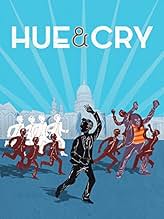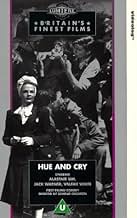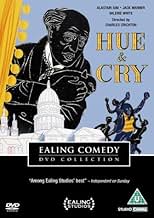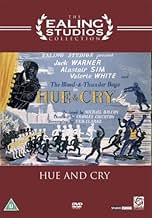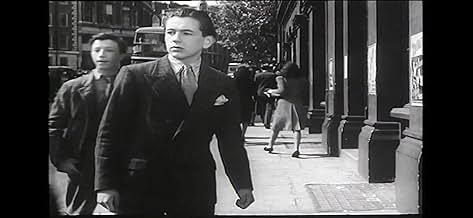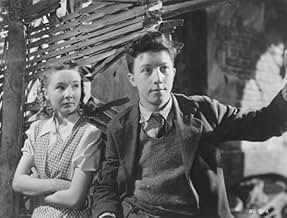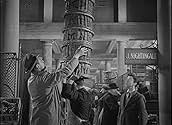Hue and Cry
- 1947
- 1 घं 22 मि
अपनी भाषा में प्लॉट जोड़ेंA gang of street boys foil a master crook who sends commands for robberies by cunningly altering a comic strip's wording each week, unknown to writer and printer. The first of the Ealing com... सभी पढ़ेंA gang of street boys foil a master crook who sends commands for robberies by cunningly altering a comic strip's wording each week, unknown to writer and printer. The first of the Ealing comedies.A gang of street boys foil a master crook who sends commands for robberies by cunningly altering a comic strip's wording each week, unknown to writer and printer. The first of the Ealing comedies.
- Terry
- (as James Crabb)
फ़ीचर्ड समीक्षाएं
Pictorially it is an interesting look at a London still suffering from the war. Most of the film was shot on location and the kids playgrounds were the bomb damaged buildings. During the climatic scenes there are some magnificent shots, taken from above, where it appears as though every kid in London is rushing through the streets to help capture the criminals.
Oddly enough, although very different, the movie had somewhat the same scenic look as THE THIRD MAN. Both were set in bomb damaged cities and in HUE AND CRY there is even a scene where the kids escape through the sewers of London, predating Harry Lime's famous scene in the sewers of Vienna.
North Americans may find the accents rather a deterrent but I think the film is well worth the effort.
Undeterred, Kirby enlists the help of a gang of bombsite-dwelling little cockneys, the self-styled 'Blood and Thunder Boys' to up-end the criminals' dastardly plans. Wilkinson is persuaded to alter his copy and catch the robbers, headed by Kirby's boss Nightingale (Warner, cast against type as a baddie), and Trump secretary Rhona Watson (White).
Originally billed with the slogan, "The Ealing film that begs to differ", Hue And Cry is less a comedy (actually, it's Ealing Studios' first acknowledged 'comedy') than a thrilling adventure story for older kids; the occasional punch-up scenes are peculiarly realistic. Director Crichton weaves a fantastic, but bizarrely believable yarn, helped no end by his unsentimental, dedicated cast.
The standout performer is Sim, whose potty writer, despite limited screen time, pretty much waltzes off with the entire picture - whether he's castigating the crooks ("The insolent scoundrels, they've purloined one of my codes - the very code I invented for the 'Case of the Limping Skeleton!'") or tremulously backing out of the deal ("Remember what happened to Nicky the Narc in the 'Case of the Creeping Death'?").
Acclaimed cinematographer Dougie Slocombe makes great use of post-Blitz London locations, including Holborn Viaduct, Docklands, and Covent Garden - particularly for the climactic scenes of hundreds of boys teeming Battleship Potemkin-fashion down the capital's steps toward the scene of the crime. While an almost incidental scene of a small boy re-enacting an aerial dogfight on a bombsite leaves viewers in no doubt about the psychological impact of the World War II on a new generation.
A young teenager and his pals discover that a gang leader is using a "boy's magazine" (called a comic, but seemingly more of a pulp-fiction text magazine) to tell his gang what jobs to pull. At the expense of logic, this allows for a nice scene at the beginning where a boy is reading a story and the events he's reading about are simultaneously happening around him. This is billed as a comedy, and there are many amusing scenes. Sim, in a small part, is delightful as the innocent, swishy, eccentric writer of the magazine stories. And there fine comic touches, such as, when they stop to look in a store window while trailing someone, the seamstress inside sticks out her tongue. But, unexpectedly, it's as a noir film that this shines. Many scenes are filmed on-location in war-torn London. At one point the kids descend into the sewers to avoid arrest, and when it seems that they can't get out, one becomes hysterical. The lobby of Sim's building is a complete noir set. The finale, with the boy entering darkness to follow the villain, and their cat-and-mouse fight on the open floors of a bombed building is noir in every aspect; the setting, the action, the lighting, the whole style of filming. The fight is violent, and ends with the boy jumping from the floor above onto the villain's stomach, killing him. It's a brutal death for a man whose crime is handling hot furs, and who the boy had no "personal" reason to kill. These noir aspects are the most striking part of the film, and it might have been even better if they had been even stronger. As it is, this Ealing film is still one of the best British films of the immediate post-war period.
क्या आपको पता है
- ट्रिवियाHarry Fowler later married fellow actress Joan Dowling, but sadly she committed suicide in 1954, aged just 26.
- गूफ़When the kids are in the tunnels and using their torches, the circle of light from the torches don't match where they are actually pointing them.
- भाव
[Joe has pleaded with Wilkinson to write a story to entrap the crooks; Wilkinson will have to stay up all night to write it]
Felix H. Wilkinson: Oh, how I loathe adventurous-minded boys.
- क्रेज़ी क्रेडिटIn the opening credits, there appears on the wall a drawing of 'Chad', beside which is written WOT NO PRODUCER ?
The producer's name, Michael Balcon, appears in the next frame.
टॉप पसंद
- How long is Hue and Cry?Alexa द्वारा संचालित
विवरण
- चलने की अवधि1 घंटा 22 मिनट
- रंग
- पक्ष अनुपात
- 1.37 : 1
इस पेज में योगदान दें



